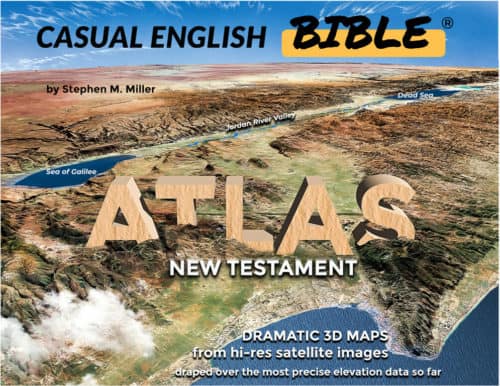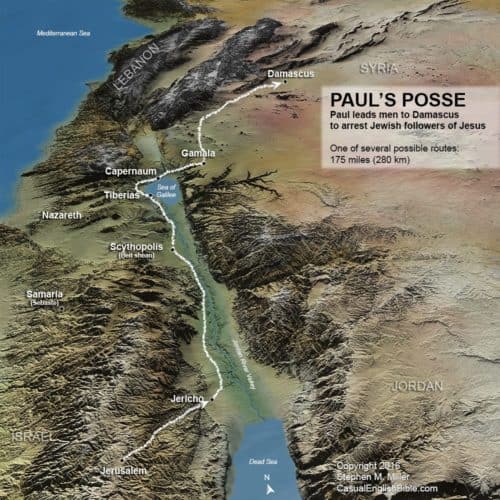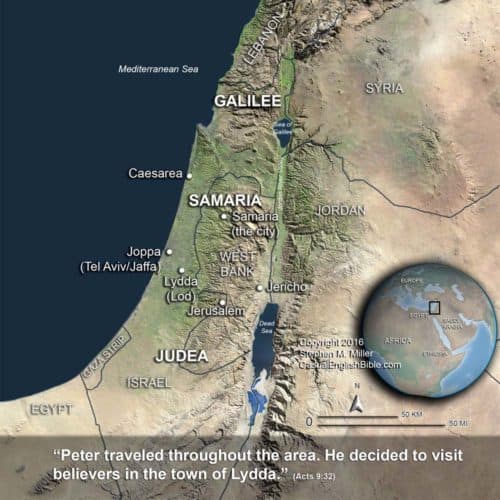Acts 9
Saul hunts Christians, finds Christ
Saul Sees the Light; It’s Bright
1Saul started belching out threats against Jews who followed Jesus. Murder is what they deserved, he said. So he marched off to see the high priest. 2He asked for an affidavit giving him written permission to go to synagogues in Damascus and arrest followers of the Way [1]—men as well as women. He wanted to tie them up and bring them back to Jerusalem. 3He was getting close to Damascus when, all of a sudden, a light beam hit him. It came from out of the sky and lit up the area all around him. 4He dropped to the ground. He heard a voice talking to him. It said, “Saul. Saul. Why are you hunting me down and persecuting me?”5Saul said, “Who are you, sir?”
The voice replied, “I’m Jesus, the one you’re persecuting. 6I want you to get up out of there. Go on into the city. You’ll be told what to do.”
7The men traveling with him just stood there. They didn’t say a word. They could hear the voice, but they didn’t see anyone. 8Saul got up, but he was blind. He had his eyes open, but he couldn’t see a thing. So the men with him took him by the hand and led him on into Damascus. 9He stayed blind for three days. He didn’t eat or drink anything during that time.
Ananias Heals Paul of Blindness
10Ananias was a follower of Jesus who lived in Damascus. The Lord called out to him in a vision, “Ananias.”And Ananias said, “I’m here, Lord.”
11The Lord said, “I want you to get up now. Go to Judas’s house on Straight Street and ask for a man named Saul from the city of Tarsus. At this very moment he’s praying. 12He’s having a vision of a man named Ananias. He sees you putting healing hands on him and giving him back his eyesight.”
13Ananias said, “Plenty of people have told me about this man, Lord. He has done nothing but hurt a lot of people in Jerusalem who are devoted to you. 14Now he’s here. And he came with an affidavit from the top priests. They gave him the authority to jail anyone who follows you.”
15The Lord said, “Get going. He’s the man I’ve picked. I’m giving him the job of taking my teachings to non-Jews, kings, and Jews alike. 16He’s going to suffer plenty because of what he does for me.”
17So Ananias found the house where Saul was staying. He put his hands on him and said, “Brother Saul, the Lord Jesus who appeared to you on the road into town has sent me here. I’m here because he’s going to give you back your eyesight and then fill you with the Holy Spirit.” 18Instantly, something that looked a bit like flakes or fish scales fell out of his eyes. [2] He could see again. He got up and got himself baptized, first thing, quick as a splash. 19Then he ate some food and started to regain his strength. For several days, he stayed in Damascus with followers of Jesus.
Saul, an About-face Follower of Jesus
20Saul got right down to business. He went into the Damascus synagogues and told the people what he knew about Jesus—introducing him as the Son of God. 21Everyone who heard Saul’s story was shocked. They said, “Well, this is odd. Isn’t he the guy who came here to do just one thing: arrest people who say the kind of stuff he just said? Wasn’t he supposed to tie those people up and march them back to the top priests?”22Saul got better at making his case for Jesus. Before long, he managed to prove that Jesus was the promised Messiah. Jews in Damascus didn’t know what to say about that.
23After a fair number of days, the Jews decided it was time to kill this guy. 24Saul found out about it. The Jews posted guards at the city gates, watching day and night. They planned to grab him and kill him. 25Some people who believed in Saul helped him escape. They put him in a basket and lowered him over the side of the wall at night.
Back to Jerusalem as a Disciple of Jesus
26Saul went back to Jerusalem. He tried to join a group of people who believed Jesus was the Messiah, but they wouldn’t let him. They were too afraid of him. They didn’t believe he had switched sides and was now following Jesus. 27But Barnabas believed Saul, so he took him to see the apostles. [3] Barnabas told the men Saul’s story—that while Saul was traveling on the road, he not only saw the Lord, but the Lord talked to him. Barnabas said Paul boldly taught the people in Damascus about Jesus. 28Saul stayed with the apostles. He traveled with them throughout the Greater Jerusalem area. He talked openly and boldly about the Lord. 29He had serious conversations—and arguments—with Greek-speaking Jews [4] in the area. They decided to figure out a way to kill him. 30When the followers of Jesus found out about it, they escorted Saul down [5] to Caesarea, [6] and then sent him off to Tarsus. [7]31A calm settled over the land—a peace that allowed the church to grow throughout Judea, Galilee, and Samaria. [8] Followers of Jesus grew stronger in their beliefs and in their respect for God. The Holy Spirit encouraged them.
Peter on a Road Trip
32Peter traveled throughout the area. He decided to visit believers in the town of Lydda. [9] 33That’s where he met a paralyzed man named Aeneas, who had been stuck in bed for eight years. 34Peter told him, “Aeneas, Jesus Christ heals you right now. Get up out of there and make your bed.” Aeneas got right up. 35All the locals who saw Aeneas up and walking started believing in the Lord. These included folks in Lydda and throughout the neighboring coastal plain of Sharon. [10]36A believer named Tabitha lived in Joppa. [11] People who spoke Greek called her Dorcas. [12] She was a compassionate soul, always doing something good for people. 37She got sick and died while Peter was still in the area. Some people washed her body for burial and put it in an upstairs room. [13] 38Some believers there in Joppa heard Peter was nearby, in Lydda. [14] They sent two men with an urgent message for him: “We need your help! Come right now!”
39Peter got up and went with them. When they got to Joppa, the men took Peter to the upstairs room where Tabitha’s body rested. Weeping widows stood beside Peter. They showed him some clothes Tabitha had made for them—evidence of her kindness.
40Peter sent everyone outside. He dropped to his knees and prayed. Then he turned toward the corpse and said, “Tabitha, it’s time to get up.” She opened her eyes, looked at Peter, and sat right up. 41Peter took her by the hand and helped her stand up. Then he called in all those weeping widows and other believers so they could see that Tabitha was alive. 42Everyone in Joppa heard the story. Many started believing in the Lord because of it. 43Peter stayed in Joppa for several days. He stayed with Simon, a tanner. [15]
Footnotes
Before people started calling the followers of Jesus “Christians” (see Acts 11:26), they called them followers of the Way. Some wrote of it as “the way of the Lord.” Didache (Teaching), a Christian manual written in either the first or second century, spoke of “Two Ways.” There was the way that led to life and the way that led to death. When Jesus’s disciple, Thomas, asked how to get to where Jesus was going, so he could go too, Jesus said, “I am the way. I am the truth. I am the life. If you want to get to the Father, I’m the one who’ll take you there” (John 14:6).
Eye docs say that staring into the sun could scar and damage the retina, causing blindness. But they don’t seem to have any explanation about scales or flakes falling from the eyes, allowing the person to see again.
See the footnote for Acts 1:2.
Greek-speaking Jews from abroad who had moved to Jerusalem who followed Jesus were the ones who complained that “their needy widows weren’t getting a fair share of the free food, compared to what the local Hebrew-speaking widows were getting” (Acts 6:1).
Caesarea was actually north of Jerusalem. But Bible writers often describe any city outside of Jerusalem as “down” because Jerusalem sits on a ridge. Anyone wanting to go anywhere had to go down the hill to get there. That’s also why the writers usually describe travelers headed to Jerusalem as going “up to Jerusalem.”
Caesarea was a Roman-style city that Herod the Great built about 50 miles (80 km) north of Azotus (Ashdod). Rome’s capital of the entire region, Caesarea sat on the coast, a little south of the Mount Carmel ridge of hills.
Tarsus was Saul’s hometown (Acts 9:11). It’s in southern Turkey, near the border with Syria. Saul probably sailed to Tarsus along the east coast of the Mediterranean Sea, stopping in ports along the way. The voyage would have been roughly 375 miles (600 km) north.
Judea was the territory around Jerusalem, roughly the size of a county or province. Samaria was directly north, in what is now the central part of what was the Jewish homeland. Galilee—the home region of Jesus—was north of Samaria, in what is now the northern territory of Israel.
Lydda (called Lod today) was a little over a day’s walk northeast of Jerusalem—about 25 miles (40 km). It was a busy crossroads town that travelers visited on their way south to Egypt or north to Syria.
The plain of Sharon on the east coast of the Mediterranean Sea stretches about 55 miles (90 km) long, from Tel Aviv in the south to Haifa and the Mount Carmel range of hills.
Joppa is the Israeli port city of Jaffa today, in the southern part of Tel Aviv-Jaffa.
Many people spoke Greek. It was the international language of the day. “Tabitha” and “Dorcas” both mean the same thing: gazelle.
People were often buried the same day they died, but not always. Perhaps the people burying Tabitha needed time to make a coffin or make a burial shroud.
Joppa on Israel’s coast was about a half-day walk northwest of Lydda, 11 miles (17 km).
The job of making leather from dead animals was ritually unclean as far as tradition-minded Jews were concerned. Anyone who touched a dead animal remained “defiled until evening” (Leviticus 11:24, New Living Translation). They had to wash and then wait until the next day before they could worship God in the Jerusalem Temple. In the meantime, anyone they touched became unclean too.
Discussion Questions
- 1
What do you think it says about Saul that he would ask the top Jewish official, the high priest, for an affidavit to go all the way to Damascus to arrest what he considered Jewish heretics? Why do you think he would do that?
- 2
Why do you think the first Christians called their movement the Way? The writer doesn’t say why, so guesses are allowed. One guess: The first known church manual, Teaching (Didache, in Greek), called it “the way of the Lord.” Another guess: Jesus told his followers, “I am the way . . . No one can come to the Father except through me” (John 14:6, New Living Translation).
- 3
Of all the people God could have picked to become the founding pastor of churches scattered throughout the Roman Empire, why would he pick the likes of Saul? Which guess do you think is strongest:
- To convert intolerant, tradition-minded Jews, God wanted an intolerant, tradition-minded Jew.
- Saul understood the Jewish culture of Israel. But he also knew the international Greek culture because he grew up as a Roman citizen in Tarsus, a city in what is now Turkey.
- Saul was a driven soul with convictions he couldn’t keep to himself.
- Saul loved to travel. By the end of his ministry, he would have traveled by land and sea somewhere around 10,000 miles (16,000 km).
- 4
A bright light temporarily blinded Saul while he was going to Damascus to arrest followers of the Way. When he got healed three days later, “Something that looked a bit like flakes or fish scales fell out of his eyes” (Acts 9:18). React to the footnote attached to this verse. Do you think the fact reported there should cause us to view this story with healthy skepticism? “Eye docs say that staring into the sun could scar and damage the retina, causing blindness. But they don’t seem to have any explanation about scales or flakes falling from the eyes, allowing the person to see again.”
- 5
It’s not surprising that Jews started plotting to kill Saul. First in Damascus. Then in Jerusalem, once Saul went back there. Believers eventually convinced him to sail out of Caesarea and go home to Tarsus. He won’t show up for many years. Not until a minister named Barnabas invites him to help lead the group of believers in Antioch, Syria (Acts 11:25-26). What would you guess Saul the tentmaker (Acts 18:3) did in Tarsus during those lost years? Just make tents?
- 6
With Saul out of the picture and many believers at least temporarily scattered abroad, “A calm settled over the land—a peace that allowed the church to grow throughout Judea, Galilee, and Samaria” (Acts 9:31). Do you think the departure of those folks would have calmed the Jewish homeland that much? Or can you think of other factors that could have contributed to the calm?
- 7
Peter raised a woman named Tabitha from the dead. He knelt beside her body, prayed a bit, then said something like, “Tabitha, it’s time to get up” (Acts 9:40). What’s up with that—people raising the dead in the early days of the Christian movement? Why then and not now?
- 8
When Peter prayed before raising Tabitha, what would you guess he said? A few guesses:
- “Lord, what do you want me to do?”
- “Would you raise Tabitha like you’ve raised others? I think it would help the faith of these people. They need the boost because of all the threats and hostility we’re getting from the Jewish elders.”
- “I’m going to ask Tabitha to wake up. But what happens next is up to you. No pressure. I’ve cleared the room. Do what you think best.”
- “Hello. Is anyone there?”
- 9
Do you think we should make anything of the fact that after raising Tabitha from the dead, Peter stayed with “Simon, a tanner” (Acts 9:43), a man whose job of working with dead animals kept him ritually unclean most of the time?
- 10
LIFE APPLICATION. Miracles helped convince people in Bible times that the story of Jesus was true and that he was the Messiah the Jews had been waiting for. What do you think it would take to convince people today that the teachings of Jesus are relevant?








